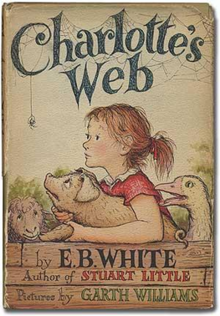Charlotte's Web

First edition
|
|
| Author | E. B. White |
|---|---|
| Illustrator | Garth Williams |
| Cover artist | Garth Williams |
| Country | United States |
| Language | English |
| Genre | Children's |
| Publisher | Harper & Brothers |
|
Publication date
|
1952 |
| Pages | 192 |
Charlotte's Web is a children's novel by American author E. B. White and illustrated by Garth Williams; it was published in October 15, 1952, by Harper & Brothers. The novel tells the story of a pig named Wilbur and his friendship with a barn spider named Charlotte. When Wilbur is in danger of being slaughtered by the farmer, Charlotte writes messages praising Wilbur (such as "Some Pig") in her web in order to persuade the farmer to let him live.
Written in White's dry, low-key manner, Charlotte's Web is considered a classic of children's literature, enjoyable to adults as well as children. The description of the experience of swinging on a rope swing at the farm is an often cited example of rhythm in writing, as the pace of the sentences reflects the motion of the swing. In 2000, Publishers Weekly listed the book as the best-selling children's paperback of all time.
Charlotte's Web was adapted into an animated feature by Hanna-Barbera Productions and Sagittarius Productions in 1973. Paramount released a direct-to-video sequel, Charlotte's Web 2: Wilbur's Great Adventure, in the U.S. in 2003 (Universal released the film internationally). A live-action film version of E. B. White's original story was released in 2006. A video game based on this adaption was also released in 2006.
After her father spares the life of a piglet from slaughtering it as runt of the litter, a little girl named Fern Arable nurtures the piglet lovingly, naming him Wilbur. On greater maturity, Wilbur is sold to Fern's uncle, Homer Zuckerman, in whose barnyard he is left yearning for companionship but is snubbed by other barn animals, until befriended by a barn spider named Charlotte, living on a web overlooking Wilbur's enclosure. Upon Wilbur's discovery that he is intended for slaughter, she promises to hatch a plan guaranteed to spare his life. Accordingly, she secretly weaves praise of him into her web, attracting publicity among Zuckerman's neighbors who attribute the praise to divine intervention. As time passes, more inscriptions appear on Charlotte's webs, increasing his renown. Therefore, Wilbur is entered in the county fair, accompanied by Charlotte and the rat Templeton, whom she employs in gathering inspiration for her messages. There, Charlotte spins an egg sac containing her unborn offspring, and Wilbur, despite winning no prizes, is later celebrated by the fair's staff and visitors (thus made too prestigious alive to justify killing him). Exhausted apparently by laying eggs, Charlotte remains at the fair and dies shortly after Wilbur's departure. Having returned to Zuckerman's farm, Wilbur guards Charlotte's egg sac and is saddened further when the new spiders depart shortly after hatching. The three smallest remain, however. Pleased at finding new friends, Wilbur names the spiderlings Joy, Nellie, and Aranea, and the book concludes by mentioning that more generations of spiders kept him company in subsequent years.
...
Wikipedia
